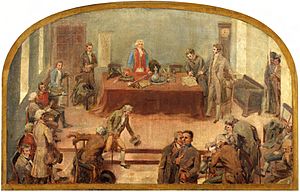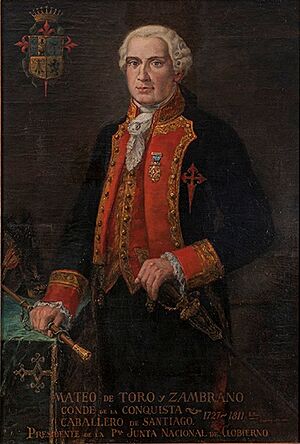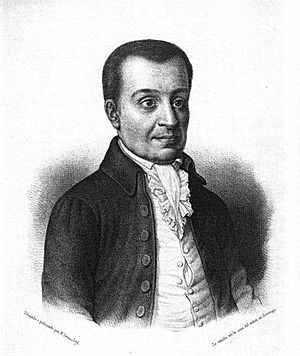Government Junta of Chile (1810) facts for kids
The Government Assembly of the Kingdom of Chile (September 18, 1810 – July 4, 1811), also known as the First Government Assembly, was a special group formed to rule Chile. This happened after King Ferdinand VII of Spain was captured by Napoleon Bonaparte. It was the very first step in Chile's fight for independence. Today, Chile celebrates the day this assembly was formed as its national holiday, called Fiestas Patrias.
Contents
Why the Assembly Was Formed
In early 1808, Chile was a small and not-so-rich colony of the Spanish Empire. Its governor, Luis Muñoz de Guzmán, was well-liked. But in May 1808, big news arrived: Napoleon Bonaparte had taken over Spain! He forced King Charles IV and his son, Ferdinand VII, to give up their thrones. Napoleon then put his own brother, Joseph Bonaparte, in charge of Spain. This caused a lot of confusion and worry across the Spanish Empire.
Meanwhile, Chile had its own problems. Governor Guzmán had died suddenly. A new governor couldn't be chosen quickly. So, a military leader named Brigadier Francisco Antonio García Carrasco took over in April 1808.
Soon, news reached Chile about Napoleon's invasion of Spain. People also learned that a special group, called the Supreme Central Junta, had been formed in Spain to rule while the king was away. At the same time, Charlotte Joaquina, King Ferdinand's sister, who lived in Brazil, also tried to take control of the Spanish colonies in America. She believed she should rule because her father and brother were prisoners.
Governor García Carrasco was a harsh leader. He quickly made many important Chilean people angry. Even though most people in Chile were loyal to the Spanish king, they were divided. Some, called absolutists, wanted things to stay exactly as they were. Others, called carlotistas, wanted Charlotte Joaquina to be queen. A third group, called juntistas, wanted to create a local government, a "junta," made up of important citizens. This group would rule Chile until the king returned.
In 1809, Governor García Carrasco was caught in a corruption scandal. This made people trust him even less. By June 1810, more bad news arrived: Napoleon's forces had taken over most of Spain. Only the city of Cádiz was still free. The Supreme Central Junta in Spain had also been replaced by a new group called the Regency Council. García Carrasco made things worse by arresting important citizens without good reason, just because he suspected them of supporting the "junta" idea.
Inspired by events in Argentina, many Chilean leaders wanted more control over their own affairs. They were very upset by the arrests and the news from Spain. So, Governor García Carrasco was forced to resign on July 16, 1810. He was replaced by the oldest military officer, Mateo de Toro Zambrano, who was 82 years old and born in Chile.
Right after Toro Zambrano became governor, the "juntistas" started pushing him to form a local junta. In August, the Royal Appeals Court publicly promised loyalty to the new Regency Council in Spain. This put more pressure on the governor. After thinking it over, Toro Zambrano agreed to hold a special meeting of the city council (called a Cabildo) in Santiago to discuss the idea. The meeting was set for September 18, 1810.
Leaders of the Assembly
| Position | Name |
|---|---|
| President | Mateo de Toro Zambrano |
| Vice President | José Martínez de Aldunate |
| Members | Fernando Márquez de la Plata Juan Martínez de Rozas Ignacio de la Carrera Cuevas Colonel Francisco Javier de Reyna Juan Enrique Rosales |
| Secretaries | José Gaspar Marín José Gregorio Argomedo |
How the Assembly Was Formed
The "juntistas" were very organized. They made sure their supporters were invited to the meeting. On September 18, they loudly demanded, "¡Junta queremos! ¡junta queremos!" ("We want a junta! We want a junta!"). Governor Toro Zambrano, seeing how many people supported the idea, placed his special staff on the table and said, "Here is the baton, take it and rule."
This led to the creation of the Government Assembly of the Kingdom of Chile, also known as the First Junta. It had the same powers as a Royal Governor. The idea of a local government won out over simply obeying the Regency Council in Spain. However, this didn't mean they wanted full independence right away. They just wanted to manage their own affairs while the king was captured.
First Actions of the Assembly
The first thing the new assembly did was promise loyalty to King Ferdinand VII. Toro Zambrano was chosen as President. Other positions were shared among different groups, but the real power was held by the secretary, Juan Martínez de Rozas.
The assembly then took important steps that Chileans had wanted for a long time:
- They created a local army to defend the kingdom.
- They allowed free trade with all countries that were allies of Spain or neutral.
- They set a special tax rate for imports, but books, printing presses, and guns were tax-free.
- To get more people involved, they called for a National Congress to be formed.
Soon, political disagreements started among the leaders. News of the wars in Europe kept coming in. It was decided that elections for the National Congress, which would have 42 representatives, would be held in 1811. By March, 36 representatives had been elected from most major cities, except Santiago and Valparaíso.
Political Groups Emerge
After President Mateo de Toro Zambrano died in February 1811, Juan Martínez de Rozas took over.
Three main political groups began to appear:
- The moderates (moderados), led by José Miguel Infante, were the largest group. They wanted slow changes because they worried that if the king returned, he would cancel everything if he thought they were trying to become fully independent.
- The exalted (exaltados) were the second largest group, led by Juan Martínez de Rozas. They wanted more freedom from Spain and faster changes, but still not full independence.
- The royalists were against any changes at all. They wanted things to stay exactly as they were.
Figueroa's Rebellion
The elections for the National Congress were very important. In Concepción, the royalists won, which was a surprise. In other parts of Chile, the votes were split. So, the Santiago elections were key for Rozas to stay in power. These elections were supposed to happen on April 10.
However, on April 1, a royalist colonel named Tomás de Figueroa started a rebellion in Santiago. He thought the idea of elections was too much like a popular uprising. The rebellion failed, and Figueroa was arrested and quickly executed. While the rebellion temporarily stopped the elections, it also made people's political views stronger. Even though the "moderates" won most seats in the National Congress, a small but strong group of "exalted" revolutionaries now wanted complete and immediate independence from Spain.
Because of the rebellion, Martinez de Rozas was replaced by Fernando Márquez de la Plata on April 2, 1811. The Royal Appeals Court, which had always supported the Spanish king, was shut down because it was thought to be involved in the rebellion. For the first time, the idea of full independence gained real support. The First Government Assembly lasted until July 4, 1811, when it was replaced by the National Congress.
See also
 In Spanish: Primera Junta de Gobierno de Chile para niños
In Spanish: Primera Junta de Gobierno de Chile para niños
- Chilean War of Independence
- Figueroa mutiny
- History of Chile
- List of government juntas of Chile
- List of heads of state of Chile
- Junta (Peninsular War)
- First Chilean National Congress





